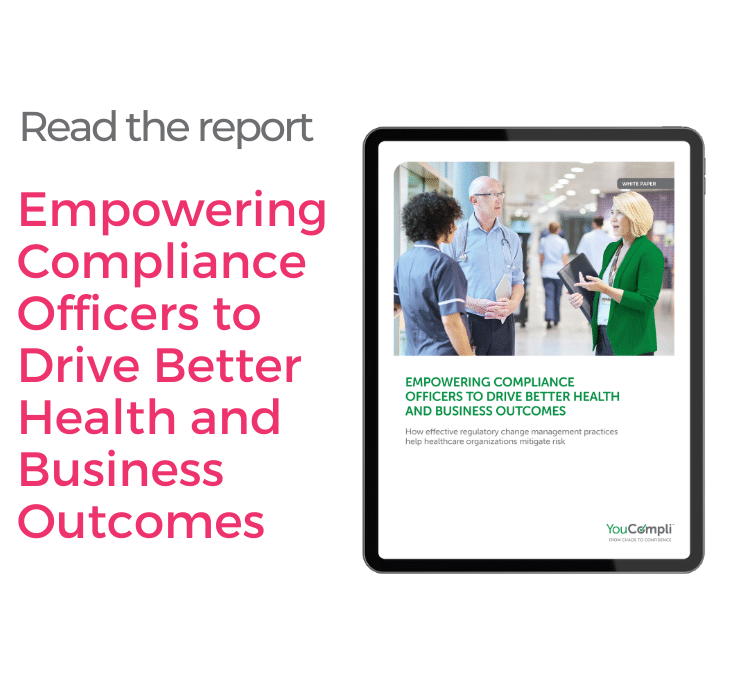CJ Wolf, MD writes enforcement action summaries for the YouCompli blog. These summaries provide real-world examples of regulators’ response to practices that don’t fully comply with regulations.
This month’s article looks at physician coding and billing cases. It reflects remarks CJ made at HCCA’s 2022 Compliance Institute. (For more insights from the Compliance Institute, download our white paper on how compliance professionals can help healthcare institutions mitigate risk.)
Physicians are often seen as the drivers in healthcare. They examine patients, order labs and diagnostic testing. They perform procedures and surgeries, admit patients to hospitals, and document in the medical record.
If you ask physicians what they think about coding and billing, most of them will tell you this: The rules do not make sense, are hard to understand, and are constantly changing. Most of them are doing their best to apply the confusing rules as they care for patients. Some might even be billing improperly on purpose. Either way, these examples highlight the consequences of “getting it wrong.” They offer clues for compliance professionals to spot training opportunities before they become enforcement actions.
Billing for services not needed or received
In March of 2022, a New Jersey rheumatologist was convicted by a federal jury for defrauding Medicare and other health insurance programs. She had billed for services that were either unnecessary or were not provided. Court documents demonstrated the physician billed for expensive infusion medication that her practice never purchased. She also fraudulently billed millions of dollars for allergy services that patients never needed or received. The doctor will be sentenced in July for multiple counts of healthcare fraud. Each count carries a maximum penalty of 10 years.
Compliance officers should watch for:
Follow the money. If a practice is billing millions of dollars for allergies services, that code or set of codes is likely to stand out as an outlier to compliance programs monitoring all their billing data. Compliance officers should have a true sense of what their organization’s bread and butter services are. Then, they should perform regular audits of those high dollar, high volume services.
Billing for unnecessary urine drug testing
A Florida physician, serving as a medical director for a sober living facility, was found guilty of healthcare fraud. The federal jury found that he had ordered medically unnecessary urine drug tests. Court documents showed the physician unlawfully billed approximately $110 million of urinalysis (UA) drug testing services that were medically unnecessary for patients. Some of the evidence used at trial included inappropriate standing orders for UA drug tests in exchange for a monthly fee. As a condition of residency, patients had to submit to excessive and medically unnecessary urine drug testing three to four times per week.
Evidence also showed the medical director did not review the UA drug test results and did not use the UA drug tests to treat the patients. This lack of review called the necessity of the tests into question. In addition, the doctor had these same patients sent to his office so he could also fraudulently bill for services through his own practice. He faces up to 20 years in prison for healthcare fraud and wire fraud conspiracy. He faces another 10 years for each of eleven counts of healthcare fraud.
Compliance officers should watch for:
If your organization allows for standing orders, you should have a written policy that guides their use. The policy should outline the risks and benefits of the standing orders. It should describe when they are appropriate and when they are not appropriate. That policy should also outline the process for reviewing standing orders on a regular basis to determine if they are still appropriate. If it’s been more than a year since you’ve reviewed a standing order, you may want to schedule a review soon.
Modifier misuse: unbundling under modifier 25
Billing and coding modifiers can also be an area of risk for physicians. In general, most encounters are reported with one Healthcare Common Procedure Coding System / Current Procedural Terminology (HCPCS/CPT) code. Medicare generally prohibits healthcare providers from separately billing for E&M services provided on the same day as another medical procedure. The exception is if the E&M services are significant, separately identifiable, and above and beyond the usual preoperative and postoperative care associated with the medical procedure.
When the E&M service meets this definition, modifier 25 can appropriately be appended to the E&M code. When that is done, a physician is, in essence, certifying that the procedure and E&M are separate enough to meet the definition of the modifier.
A urology practice learned an expensive lesson by allegedly using modifier 25 inappropriately. The practice agreed to pay $1.85 million to resolve allegations of modifier misuse. The case was initiated by a qui tam whistleblower. Allegedly the practice used modifier 25 to improperly unbundle routine E&M services that were not separately billable from other procedures performed on the same day. As a result, the practice improperly claimed compensation from Medicare for certain urological services. The whistleblower had performed audits that allegedly showed an overall error rate for the practice of 58% with some physicians showing a 100% error rate.
Compliance officers should watch for:
Any specialty could potentially run into problems with modifier 25. Consider common clinical scenarios such as a scheduled procedure. For example, in urology a physician might schedule a patient to return to the office another day for a scope procedure or a prostate biopsy. Frequently, upon return, the procedure is performed but a significant, separately identifiable evaluation and management service might not be performed. In those cases, it would not be appropriate to bill the procedure and an E&M service, but rather only the procedure. Automatically billing an E&M with modifier 25 just because the patient was in the office would be a red flag.
Conclusion
Physicians and their practices need to be aware of coding and billing risks. Enforcement agencies and potential whistleblowers may identify outliers or flat-out fraud. Common mistakes may include a lack of documentation or not performing a service but billing for it anyway. Other common mistakes are billing for procedures or services that were performed but were not medically necessary and misuse of medical codes and/or modifiers.
CJ Wolf, MD, M.Ed is a healthcare compliance professional with over 22 years of experience in healthcare economics, revenue cycle, coding, billing, and healthcare compliance. He has worked for Intermountain Healthcare, the University of Texas MD Anderson Cancer Center, the University of Texas System, an international medical device company and a healthcare compliance software start up. Currently, Dr. Wolf teaches and provides private healthcare compliance and coding consulting services as well as training. He is a graduate of the University of Illinois at Chicago College of Medicine, earned a master’s in education from the University of Texas at Brownsville and was magna cum laude as an undergraduate at Brigham Young University in Provo, UT. In addition to his educational background, Dr. Wolf holds current certifications in medical coding and billing (CPC, COC) and healthcare compliance, ethics, privacy and research (CHC, CCEP, CHPC, CHRC).
Managing regulatory change is a critical way to avoid enforcement actions. YouCompli is the only healthcare compliance solution that combines actionable, regulatory analysis with a simple SaaS workflow to help you manage regulatory change. Read more about the rollout and accountability of requirements or schedule a demo.
Download our white paper on how compliance professionals can help healthcare institutions mitigate risk.









